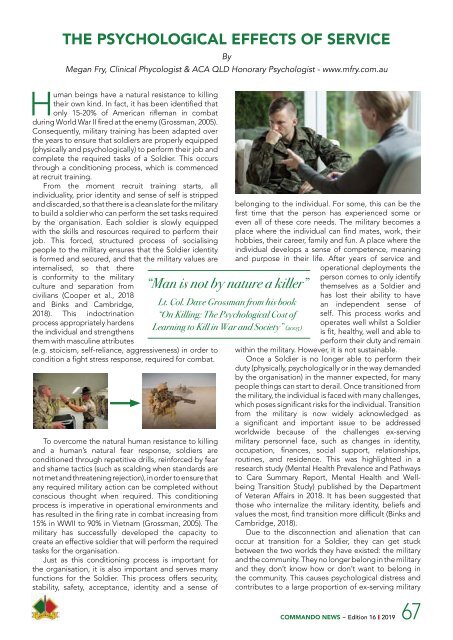COMMANDO News Magazine - Edition 16, 2019
The Official Commando News Magazine
The Official Commando News Magazine
- No tags were found...
Create successful ePaper yourself
Turn your PDF publications into a flip-book with our unique Google optimized e-Paper software.
THE PSYCHOLOGICAL EFFECTS OF SERVICE<br />
By<br />
Megan Fry, Clinical Phycologist & ACA QLD Honorary Psychologist - www.mfry.com.au<br />
Human beings have a natural resistance to killing<br />
their own kind. In fact, it has been identified that<br />
only 15-20% of American rifleman in combat<br />
during World War II fired at the enemy (Grossman, 2005).<br />
Consequently, military training has been adapted over<br />
the years to ensure that soldiers are properly equipped<br />
(physically and psychologically) to perform their job and<br />
complete the required tasks of a Soldier. This occurs<br />
through a conditioning process, which is commenced<br />
at recruit training.<br />
From the moment recruit training starts, all<br />
individuality, prior identity and sense of self is stripped<br />
and discarded, so that there is a clean slate for the military<br />
to build a soldier who can perform the set tasks required<br />
by the organisation. Each soldier is slowly equipped<br />
with the skills and resources required to perform their<br />
job. This forced, structured process of socialising<br />
people to the military ensures that the Soldier identity<br />
is formed and secured, and that the military values are<br />
internalised, so that there<br />
is conformity to the military<br />
culture and separation from<br />
civilians (Cooper et al., 2018<br />
and Binks and Cambridge,<br />
2018). This indoctrination<br />
process appropriately hardens<br />
the individual and strengthens<br />
them with masculine attributes<br />
(e.g. stoicism, self-reliance, aggressiveness) in order to<br />
condition a fight stress response, required for combat.<br />
To overcome the natural human resistance to killing<br />
and a human’s natural fear response, soldiers are<br />
conditioned through repetitive drills, reinforced by fear<br />
and shame tactics (such as scalding when standards are<br />
not met and threatening rejection), in order to ensure that<br />
any required military action can be completed without<br />
conscious thought when required. This conditioning<br />
process is imperative in operational environments and<br />
has resulted in the firing rate in combat increasing from<br />
15% in WWII to 90% in Vietnam (Grossman, 2005). The<br />
military has successfully developed the capacity to<br />
create an effective soldier that will perform the required<br />
tasks for the organisation.<br />
Just as this conditioning process is important for<br />
the organisation, it is also important and serves many<br />
functions for the Soldier. This process offers security,<br />
stability, safety, acceptance, identity and a sense of<br />
“Man is not by nature a killer”<br />
Lt. Col. Dave Grossman from his book<br />
“On Killing: The Psychological Cost of<br />
Learning to Kill in War and Society” (2005)<br />
belonging to the individual. For some, this can be the<br />
first time that the person has experienced some or<br />
even all of these core needs. The military becomes a<br />
place where the individual can find mates, work, their<br />
hobbies, their career, family and fun. A place where the<br />
individual develops a sense of competence, meaning<br />
and purpose in their life. After years of service and<br />
operational deployments the<br />
person comes to only identify<br />
themselves as a Soldier and<br />
has lost their ability to have<br />
an independent sense of<br />
self. This process works and<br />
operates well whilst a Soldier<br />
is fit, healthy, well and able to<br />
perform their duty and remain<br />
within the military. However, it is not sustainable.<br />
Once a Soldier is no longer able to perform their<br />
duty (physically, psychologically or in the way demanded<br />
by the organisation) in the manner expected, for many<br />
people things can start to derail. Once transitioned from<br />
the military, the individual is faced with many challenges,<br />
which poses significant risks for the individual. Transition<br />
from the military is now widely acknowledged as<br />
a significant and important issue to be addressed<br />
worldwide because of the challenges ex-serving<br />
military personnel face, such as changes in identity,<br />
occupation, finances, social support, relationships,<br />
routines, and residence. This was highlighted in a<br />
research study (Mental Health Prevalence and Pathways<br />
to Care Summary Report, Mental Health and Wellbeing<br />
Transition Study) published by the Department<br />
of Veteran Affairs in 2018. It has been suggested that<br />
those who internalize the military identity, beliefs and<br />
values the most, find transition more difficult (Binks and<br />
Cambridge, 2018).<br />
Due to the disconnection and alienation that can<br />
occur at transition for a Soldier, they can get stuck<br />
between the two worlds they have existed: the military<br />
and the community. They no longer belong in the military<br />
and they don’t know how or don’t want to belong in<br />
the community. This causes psychological distress and<br />
contributes to a large proportion of ex-serving military<br />
<strong>COMMANDO</strong> NEWS ~ <strong>Edition</strong> <strong>16</strong> | <strong>2019</strong> 67

















